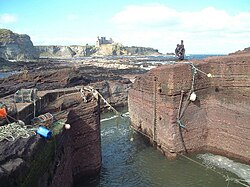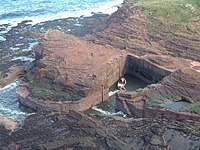Seacliff
| Seacliff | |
| East Lothian | |
|---|---|
 Seacliff Harbour and Tantallon Castle | |
| Location | |
| Grid reference: | NT619830 |
| Location: | 56°3’6"N, 2°38’6"W |
| Data | |
| Post town: | North Berwick |
| Postcode: | EH42 |
| Dialling code: | 01620 |
| Local Government | |
| Council: | East Lothian |
| Parliamentary constituency: |
East Lothian |
Seacliff is no more than a hamlet, if that, comprising a small beach, an estate and a harbour. It lies 4 miles east of North Berwick, East Lothian.
History
The beach and estate command a strategic position at the mouth of the Firth of Forth, and control of the area has been contested through the ages. The beach and estate were used as a staging post for various raids on nearby Tantallon Castle from the 14th to the 17th century. Troops were also stationed here to prevent landings by the French during the Napoleonic Wars in 1798. Before bloodshed touched the area, the 8th century Christian missionary St Baldred was based in nearby Scoughall, and several features of the area have been named after him, such as "Ghegan Rock" (Churchman's Haven).
In quieter times, the ownership of the estate has changed hands on several occasions. Seacliff House was built in 1750 by Robert Colt. It was later bought by George Sligo who in 1841 employed the famed architect David Bryce to build a new house in baronial style on the core of the older house. However, in 1907 it was gutted by fire. The exterior survives almost complete with gables, turrets and bartizans. The outbuildings were later purchased by the Royal Navy who established a top-secret research base there during First World War. The station, known as HMS Scottish Seacliff, was mainly used for navigation training and U-Boat defence.
Robert Louis Stevenson was related to the Dale family, who still own and farm much of the land around Seacliff today.
Modern day

Seacliff Beach is private, and entry for cars is controlled by a coin-operated barrier. The area is largely unspoiled and attracts surfers, dog-walkers, riders and summer picnickers.
Seacliff Harbour is a sheltered spot accessible through a narrow channel, all blasted out of the red sandstone cliffs. This was constructed in 1890 by Andrew Laidlay, the then laird, who used a steam engine and compressed air to cut the stone. It was once home to boats owned by fisherman and landowners but today it is rarely used by boats and more for diving and dive training. The entrance measures just ten feet across and it is reckoned the smallest harbour in the United Kingdom.
The estate is home to farming, the Seacliff Haulage depot and a small number of cottages.
Outside links
References
- Lost Houses of Scotland, by Marcus Binney, John Harris, and Emma Winnington, SAVE Britain's Heritage, London, July 1980. ISBN 0-905978-05-6